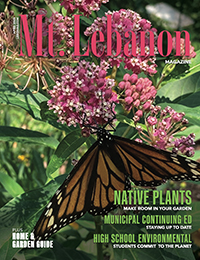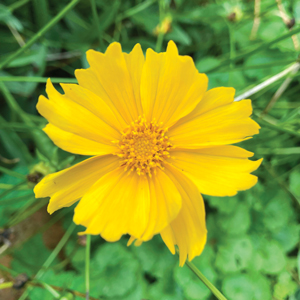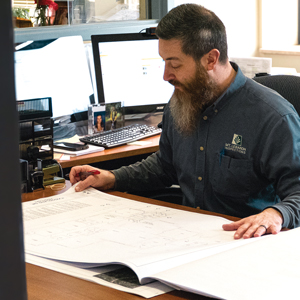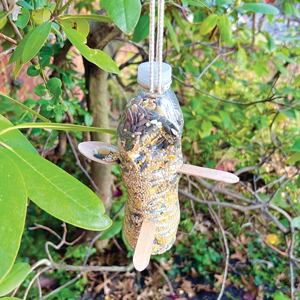Algerian Cooking

lhem Bockstaller of Greenhurst Drive, a native of Tlemcen, Algeria, has a doctorate in physics, is a professor in the department of chemical engineering at Carnegie Mellon University, speaks four languages and—maybe best of all—is an absolutely marvelous cook of her native Algerian food, especially pastries. More about those desserts in a moment.
Bockstaller and her husband, Michael, also a professor at CMU, in the department of materials science and engineering, met at the prestigious Max Planck Institute in his native Germany.
They moved to Mt. Lebanon in 2009. “We came here for the schools and the cozy, warm houses,” says Bockstaller. “We can also walk to many places, European style.” The couple’s son, Michael, goes to Jefferson Middle School.
What characterizes the Algerian food at which Bockstaller is so expert? Algeria, in North Africa along the Mediterranean Sea, is the largest country on that continent. For centuries, it was a crossroads for trade and a tempting target for conquest. The food is a highly developed amalgamation of the peoples and cultures who have touched that sunny land.
A quick summary: The indigenous Berbers contributed a taste for butter, or “smen,” homemade, aged butter, now replaced by store-bought products. Muslim Arabs invaded Africa, bringing spices such as saffron, nutmeg, cloves and cinnamon. Carthaginians introduced semolina wheat; the Romans, various grains; the Spanish, olives, plums and peaches; and the French, soups, salads and, of course, baguettes. (But not the complex French sauces, certainly not those made with milk).
The Algerian diet includes fish and meats, except pork. Meat is cooked well done by grilling or pressure cooking-—a pressure cooker is ubiquitous in Algerian kitchens—but it is still juicy,
according to Bockstaller.
Everything is fresh. “My daddy went twice a day, in the morning and afternoon, to get fresh veggies,” says Bockstaller. “He would also go to the sea to get fresh fish.” Vegetables can be part of a meal, or cooks can extract the juice from them, then add thickeners to make soups.
Bockstaller’s friend, Nadia, who grew up in Algiers and is a multilingual retired dentist, joined the conversation. “Spices are also fresh. There are stores that have only spices. But if you want to really taste the flavor, you grind your own.”
Couscous, those little beads of semolina flour, is the national dish. Traditional cooks make the dough, roll it out, scrape it through a sieve, steam, salt, fluff, steam again. Ilhem did that growing up, in addition to helping clean the house and wash the floors daily. “My grandma, aunt, mom and I made couscous from scratch every Friday,” she recalls. “Lately women don’t do it because you can buy it. But you still have to steam it two times.”
Regional variations add twists to the dish. Tlemcen, in northwestern Algeria, is near Morocco, so the flavors of that region—saffron in particular—spice the couscous. In Nadia’s native Algiers, the couscous is perfumed by Tunisian flavors—black pepper, for instance,
and cinnamon.
Before and during Ramadan, which will be in April in 2020, the cooking and cleaning ramp up. That’s to be expected, since the month, which commemorates the first revelation of the Quran to Muhammad, is the holiest of the Muslim religious year.
Fresh takes on new meaning. After the house has been thoroughly scrubbed and painted comes food changes, especially disposing of out-of-date food and buying
fresh spices.
Holiday fare includes harira/chorba (soup), bourek (a kind of samosa or spring roll), with meat and salad. There is also lham lahlou, a dish made of dried prunes, raisins or plums, cooked in a syrup along with meat.
Eid al Fitr marks the end of Ramadan. That is followed two months later by Eid al Adha, which honors the willingness of Ibrahim to sacrifice his son as an act of obedience to God. Needless to say, during all those holy days every woman is eager to show that her food, especially the pastries, is the best.
Bockstaller continues to maintain the religious and recipe traditions, but not the intensive house cleaning and painting or replacing of foodstuffs.
Now, about those pastries. They are elegant confections that reveal a multitude of taste sensations as you savor them. Probably the first one you think of is baklava, made with layers of phyllo dough, but there are many others, such as boussou la tmessou, meaning, roughly, “kiss it but don’t touch it” because it is so delicate. Made of clarified butter, dipped in orange blossom water, then coated heavily with confectioners sugar, it breaks easily in your hand, but melts in your mouth. Cakes are not forgotten. Try kalb el louz (heart of the almond) which is an almond based cake steeped in syrup. And, of course, there are delicate flans.
Bockstaller recommends dziriats, which has a honey/nut filling similar to baklava but mounded in a pastry shell instead of phyllo. She prefers dziriats to baklava, especially because the ready-made phyllo here is not like the butter-based phyllo in Algeria. “What you buy here gets soggy,” says Ilhem. She made her own phyllo in Algeria, a culinary tour de force that exceeds the effort needed to make puff pastry.
Bockstaller was kind enough to share her recipe for dziriats. Try them, perhaps with a cup of traditional mint tea.

Dziriats
Algerian almond tart
courtesy Ilhem Bockstaller
Prep time: 1½ hr Cook Time: 20-30 min
For the dough:
1. 1 stick of soft butter
2. 2 cups flour
3. Water to bind
Blend flour and butter with a pastry cutter or in a food processor until the butter is well incorporated with the flour. Add just enough water to bind the dough, which should be soft and elastic. To test, slowly pull a chunk from the mass. If it is stretchy without breaking it is ready. Wrap it in plastic and let it rest while you make the filling.
For the syrup:
Can be made different ways: sugar, water and ½ of a lemon; or sugar, water ½ of a lemon and honey or blue agave; or, even better, only blue agave.
1. 2 cups sugar
2. 2 cups water
3. ½ of a lemon
4. 1½ cup honey or blue agave
Boil all ingredients until the sugar and honey or blue agave have thoroughly dissolved and a syrup has formed.
For the filling:
1. 2 eggs
2. pinch salt
3. 1 cup sugar
4. 3½ to 5 cups almond flour (if the flour is dense, you need around 3½ C and if it is fluffy you will need 5 cups or a little bit more). Once you mix everything you should be able to make balls that are not sticky.
5. zest from ¼ of a lemon
Beat the eggs with a pinch of salt until foamy. Add the sugar and beat until the mixture expands and has a creamy look. Gradually add the almond flour and zest and mix just until fully incorporated.
Make balls about one inch in diameter and place on a plate. Cover the completed balls with plastic to prevent drying.

Final Assembly:
Preheat oven to 400°. Use a non-stick muffin or cupcake pan.
1. Divide the dough into four balls. Keep the balls you are not using under plastic wrap.
2. Roll the dough on a silicon pad or board very lightly dusted with flour until it is ⅟₁₆ -⅛” thin. Or roll it through a pasta machine first set on 3, then again on 5.
3. Cut the dough into 2” diameter circles with a cookie cutter. Reserve the scraps as they can be used again with any remaining balls.
4. Place a dough disk in one hand, then an almond ball in the center. With the thumb and fingers pinch the whole piece to close over the almond ball making it look like a flower.
5. Put one cookie in each cup of the pan.
6. Continue until all the dough and filling is used.
7. Reduce the oven temperature to 375° (until heated) and put in the pans. After 10 minutes reduce the temperature to 350°.
8. Cook until the cookies turn golden, about 20-30 minutes.
9. Take the cookies out and immediately soak them in the syrup (including the dough). The cookie will swell slightly. Put them in a colander to drain.
10. When drained (there will still be some liquid), place each cookie in a paper candy cup. Let cool.
11. When cool, put cookies in an airtight container. They will stay fresh and crunchy for a week without refrigeration. Or freeze them. It takes about a half hour to defrost. Do not defrost in a microwave.





